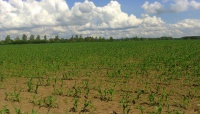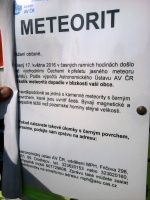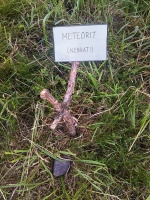(Unless otherwise stated, the copyright of the materials included belong to Jan Woreczko & Wadi.)
Hradec Králové
Z Wiki.Meteoritica.pl
| Hradec Králové → | |
| Spadek | |
| Lokalizacja | Czechy |
| Położenie[1] | 49°46'N, 14°38'E |
| Data | 17 maja 2016 r. |
| Uwagi | znalezisko związane z bolidem EN170516 |
| Charakterystyka | |
| Typ | chondryt zwyczajny LL5 |
| Masa | 134 g |
| Liczba okazów | 1 mały okaz |
| Meteoritical Bulletin Database | |
Apel do poszukiwaczy
O godz. 3:04:01,2-07,3 czasu środkowo-europejskiego 17 maja 2016 roku (wtorek) obserwowano nad północno-wschodnimi Czechami bardzo jasny bolid (–11,5m). Przelot bolidu zarejestrowały stacje bolidowe European Fireball Network (EN), a on sam otrzymał oznaczenie EN170516. Pozwoliło to wyliczyć orbitę meteoroidu i dane dotyczące ewentualnego spadku.
26 maja 2016 roku szef EN Pavel Spurný z Instytutu Astronomicznego (Astronomický ústav AV ČR) wystosował apel (U Hradce Králové spadly meteority! Pomozte je najít!) do poszukiwaczy z prośbą o pomoc w poszukiwaniu meteorytów z tego bolidu.
Za Meteoritical Bulletin Database:
Hradec Králové 50°18.03’N, 15°43.67’E
- Královéhradecký, Czech Republic
- Confirmed fall: 17 May 2016
- Classification: Ordinary chondrite (LL5)
History: (P. Spurný, CzAS[2]). A slow moving, -11.5 absolute magnitude, bolide was recorded photographically and photoelectrically by digital all-sky fireball observatories at three Czech stations of the European Fireball Network (other stations had bad weather) and by two web cameras of the Czech Hydrometeorological Institute on May 17, 2016, at 1:04:01.2-7.3 UT. Based on these instrumental data, precise results on atmospheric trajectory, heliocentric orbit, and fragmentation history were quickly determined. It was evident that this event terminated with a multiple meteorite fall and the impact area of possible meteorite masses was modeled. However, a systematic search was very complicated because the fall occurred in an agriculturally cultivated area during the high vegetation season. Nevertheless, the impact area was announced in the CzAS official press release and the public was asked for a help with the search. After dedicated search activities of several teams (including CzAS team) and individual hunters, one freshly looking meteorite was recovered by a private hunter in the predicted location for a given mass. It was found in the oil seed grape field just after the harvest on July 30, 2016 and the finder informed P. Spurný(CzAS) about his find in March 2017. The sample was immediately analyzed by J. Haloda (CzGS).
Physical characteristics: (P. Spurný, CzAS). Hradec Kralove is a single, 133 g, slightly wedge-shaped stone measuring approximately 6×3.5×2 cm with bulk density 3.23 g/cm3. About half of its surface is covered by a thick, black, primary fusion crust, where one side contains well-developed regmaglypts. The second half of its surface is covered by a very thin secondary crust signifying a break up of the meteoroid in the last moment of its ablation phase. Only a few small rusty spots are visible on its surface. One small 1.1 g fraction was chipped from this sample and was used for mineralogical/petrological analyses. Another 22.2 g was cut later and it serves as the repository mass (CzAS).
Petrography: (J. Haloda, CzGS[3]), The meteorite shows only weakly defined chondrules; sizes vary from around 0.5 mm to 5 mm. Thin section shows a complete recrystallization of a fine-grained matrix. An undulose extinction of olivine and orthopyroxene and presence of irregular fractures indicate a very weak shock stage (S2).
Geochemistry: Mineral compositions and geochemistry: (J. Haloda, CzGS), Chondrule relicts consist mostly of olivine (Fa25-33) mean Fa29.7, Fa PMD 3.5%, n=50; low-Ca pyroxene (Fs21-27Wo0.8-2.4) mean Fs24.0 Wo1.7, Fs PMD 4.7%, Wo PMD 5.7%, n=50. Feldspar grains <10 mm, chromite, chlorapatite, troilite, kamacite and taenite are also present.
Classification: (J. Haloda, CzGS), Ordinary chondrite, LL5 (S2). Weathering grade W0
Specimens: Type specimen 22.2 g + 0.5 g, CzAS; the main mass (110 g) is with the finder (M. Maršík)
Lokalizacja
(C) Čistěves, (S) Sovětice
[LL] miejsce znalezienia okazu 134 g
rejon spadku (patrz → Galerie)
wyliczony rejon ewentualnego spadku fragmentu(ów)
* W 2018 roku Google zmieniło zasady działania apletu, mapa może wyświetlać się niepoprawnie (pomaga Ctrl+F5); więcej → Szablon:GEMap-MyWiki
Na portalu Česká astronomická společnost udostępniono podstawowe informacje. Według obliczeń obserwatorów z EN na północny-zachód od Hradec Králové, pomiędzy gminami Sovětice i Čistěves, mogły spaść okazy meteorytów o wagach nawet kilkaset gramów. Na zamieszczonej tam mapie zaznaczono prawdopodobny rejon spadku fragmentów, gdzie spodziewana wielkość okazów zwiększa się od północnego-zachodu na południowy-wschód, gdzie mogą być meteoryty o masie nawet jednego kilograma.
Galerie
Rejon spadku (lokalizacja miejsc patrz → mapa) (stan: przełom maja/czerwca 2016 r.; fot. Tomasz Ogłaza)
Bibliografia
- Meteoritical Bulletin Database – Hradec Králové
Przypisy
Linki zewnętrzne
- Meteoritical Bulletin Database (MBD) – meteoryt Hradec Králové
- Encyclopedia of Meteorites (EoM) – meteoryt Hradec Králové
- portal www.astro.cz (Česká astronomická společnost) – Apel: U Hradce Králové spadly meteority! Pomozte je najít!
- woreczko.pl – Sieci bolidowe (fireball network)




